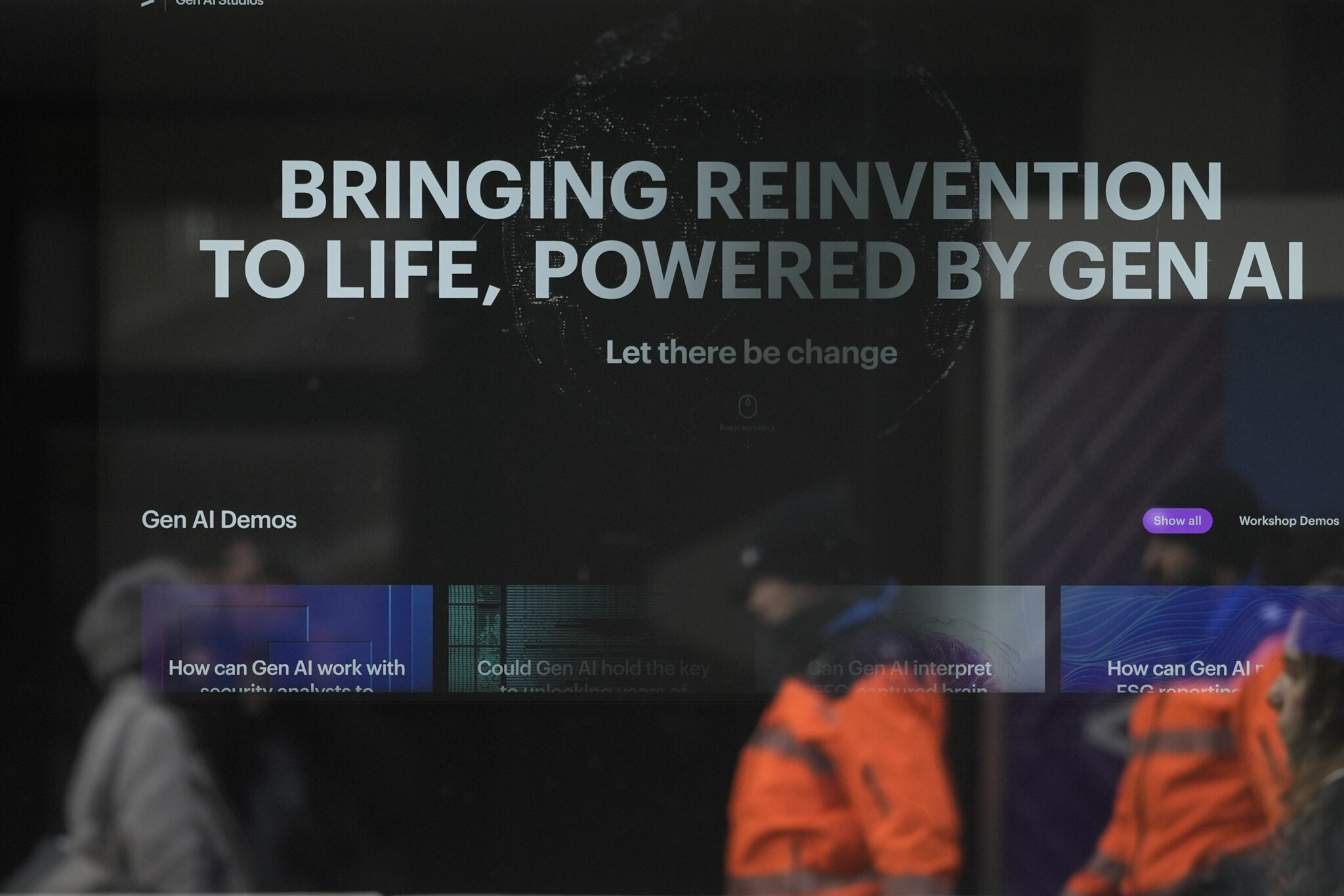DeepDives is a bi-weekly essay series exploring key issues related to the economy. The goal of the series is to provide Hub readers with original analysis of the economic trends and ideas that are shaping this high-stakes moment for Canadian productivity, prosperity, and economic well-being. The series features the writing of leading academics, area experts, and policy practitioners. The DeepDives series is made possible thanks to the ongoing support of the Centre for Civic Engagement.
Artificial intelligence represents a major growth opportunity for Canada, but only if we move faster and make the gains broad-based. A new PwC Canada report sketches three plausible 2035 futures and, in its best-case scenario, where AI adoption accelerates, Canada’s GDP is projected to reach $3.65 trillion by 2035, about 9 percent above the baseline projection.
That headline number is not a forecast so much as a map. It shows what’s at stake if we treat AI as a general-purpose technology that rewires production, services, and the public sector. The question for policymakers—and for workers—isn’t whether AI will matter, but how it will matter for different parts of the Canadian economy, who will benefit the most, and who may lose. If adoption is broad and jobs accommodate the productivity-enhancing benefits of AI, median wages could rise. However, the impact of AI use on Canadian labour markets could be profound, and some workers may find themselves displaced from technological change. We need to understand how AI could impact labour markets to ensure that support systems are prepared to aid in labour transitions, while still reaping the economic gains from the adoption of new technologies.
This DeepDive takes that AI opportunity seriously while squarely confronting questions about impacts to labour markets. First, we unpack two rival U.S. conservative scripts on how government should regulate AI use, embodied in J.D. Vance’s “build fast” optimism and Josh Hawley’s “guardrails for the working man,” as Canadian policy will likely be tugged between those poles. Then we synthesize the latest evidence on where AI is already raising productivity, where it’s displacing tasks, and which cohorts are most exposed. Finally, we assess where Canada stands on adoption, exposure, and literacy—and what it will take to turn PwC’s optimistic scenario into reality without consigning particular occupations or younger workers to bear the costs alone.
The politics of AI and work in the U.S.: Vance’s optimism vs. Hawley’s guardrails
On February 11, 2025, U.S. Vice President J.D. Vance addressed the Artificial Intelligence Action Summit in Paris. The speech, archived by the American Presidency Project, put a deregulatory, growth-first stamp on the Trump administration’s approach to AI—and framed the technology explicitly as a pro-worker opportunity. Vance set the tone early: “I’m here to talk about AI opportunity.”
In Paris, Vance argued that over-regulation—especially the European style—risks strangling a once-in-a-generation productivity revolution. He embraced a four-point program: keep the U.S. “the gold standard worldwide,” avoid “excessive regulation,” keep AI “free from ideological bias,” and maintain a “pro-worker growth path.” He also sketched an industrial strategy for compute and energy, pledging to ensure the most powerful systems and chips are built in America. Beneath the geopolitical bravado was a straightforward labour thesis: AI augments people and raises their productivity. As Vance put it:
AI, I really believe, will facilitate and make people more productive. It is not going to replace human beings. It will never replace human beings. And I think too many of the leaders in the AI industry—when they talk about this fear of replacing workers, I think they really miss the point. AI, we believe, is going to make us more productive, more prosperous, and more free.
And when it comes to jobs, he was unequivocal:
From law to medicine, manufacturing, the most immediate applications of AI almost all involve supplementing, not replacing, the work being done by Americans.
Vance is not blind to AI risks, but the centre of gravity is growth: build power plants, build fabs, build models, then trust a lightly regulated market to diffuse gains to workers via higher wages and new industries. It is Reaganite techno-optimism with on-shoring and energy realism stapled on.

People reflected in a window with a slogan about AI in Davos, Switzerland, Jan. 18, 2024. Markus Schreiber/AP Photo.
Senator Josh Hawley, speaking on September 4, 2025, at the National Conservatism Conference, offered a different conservative frame: AI as a potential bulldozer of dignified work and a vector for corporate and transhumanist overreach. He warned of self-driving vehicles “put[ting] them all out of work—near instantly” and called for a rights-based regime to protect the “working man,” spanning job reservation, data/property rights, and strict guardrails on deployment. In Hawley’s words:
Most jobs should be reserved for humans. Only humans should drive cars and trucks. Only humans should enter into contracts. Only humans should advise on critical medical treatments or act as legal agents. I say again, AI should serve human beings, not the other way around.
Hawley pressed for a “right…to pursue a vocation,” not a future where “sweeping the floor of a data centre” is the last refuge of human labour. And he floated reporting and inspection rules targeting “the tech titans” and transparency, “each time they replace a working man with a machine,” alongside openness to state-level regulation if Congress stalls.
Put side by side, Vance and Hawley converge on centring workers in AI policy, but they diverge sharply on means. Vance’s view is to reduce regulatory friction, expand computing power and energy, and let competition and training spread gains to workers. Hawley’s approach, on the other hand, is to assert human primacy in law, reserve certain categories of work for people, assign property rights to human data, require auditable reporting when AI displaces jobs, and empower states to regulate aggressively if necessary.
For Canada, deeply tied to U.S. firms, supply chains, and regulatory ideas, these two poles map the policy terrain on which our own AI-and-work debates will unfold.
What some of the latest research says about AI and labour markets
The empirical research on the impact of AI on labour markets is growing rapidly and becoming increasingly nuanced. The reality of AI adoption to date strikes a balance between the Vance and Hawley poles. Research is demonstrating that while there are productivity gains, the broader impact on labour markets is uneven. Here is what some of the latest research shows.
1) AI and hiring: fewer non-AI job postings, more demand for AI skills
Research by noted economist Daron Acemoglu utilizes establishment-level vacancy data to examine the impact of firms adopting AI. They find that AI adoption is associated with reductions in non-AI-related hiring, but the net effect on overall hiring is limited and context-dependent. Critically, adoption raises demand for workers with AI-complementary skills (roles that use or build AI) even as it discourages vacancies for roles more susceptible to automation or task substitution.
2) Generative AI at work: large productivity gains, especially for the less experienced
In a real-world deployment with a large customer-support workforce, economists Brynjolfsson, Li, and Raymond document meaningful productivity improvements when agents use a generative-AI assistant. Output per hour rises by an average of 15 percent, case resolution speeds improve, and customer satisfaction ticks up.
However, the effects are uneven across workers, with the largest gains accruing to less experienced and lower-skilled workers, suggesting that AI can act as a “skills leveller” by codifying tacit know-how from top performers. These short-run results highlight the augmentation channel in that AI can help workers move up the quality and speed curve, rather than wholesale displacement within the observed period.
3) Inside firms: AI shifts tasks, raises some employment, and widens within-firm inequality
Using microdata from Brazil, Federal Reserve Bank of Chicago economist Gustavo de Souza finds that AI adoption increases production-side employment (where AI complements or coordinates physical processes), while reducing employment and wages in administrative and clerical roles—the types of tasks that are more directly substitutable by software. The upshot is not uniform job loss but reallocation, with an uncomfortable side-effect: increased within-firm wage dispersion as some roles become more valuable and others less so. This is a modern echo of earlier IT waves, except AI reaches further into cognitive tasks.

United States Vice-President JD Vance addresses the audience at the Grand Palais during the Artificial Intelligence Action Summit in Paris, Tuesday, Feb. 11, 2025. Michel Euler/AP Photo.
4) Early U.S. labour-market signals: age cohort risks and where AI displacement shows up
In a recent study, economists Erik Brynjolfsson, Bharat Chandar, and Ruyu Chen, all of Stanford University, utilize high-frequency payroll microdata covering millions of workers across tens of thousands of U.S. firms through July 2025 to track employment dynamics in occupations differentially exposed to generative AI. Their headline finding is stark: Since the widespread adoption of AI began, early-career workers (aged 22–25) in the most AI-exposed occupations have experienced a relative decline of approximately 13 percent in employment, even after controlling for various factors.
By contrast, employment for older workers in the same occupations and for workers in less exposed fields remained stable or continued to grow. The adjustment is primarily reflected in employment rather than compensation, and the pattern is most pronounced in occupations where AI applications are automating tasks rather than augmenting them.
In short, the earliest and clearest labour-market effects of gen-AI appear to be declines in entry-level employment in highly exposed, automation-heavy occupations, even as the aggregate labour market remains resilient.
Overall, recent evidence suggests at least three things. First, there are sizable productivity gains to be had when workers use AI tools, especially those with less experience. Second, employment displacement is real, but it is concentrated. Non-AI postings fall at adopting firms; admin and clerical tasks shrink; early-career workers in certain occupations take larger hits. These losses are not totalizing, but they are meaningful and potentially politically salient in specific communities and cohorts. Third, if AI amplifies high-complementarity roles while eroding low-complementarity tasks, within-firm and across-occupation inequality can widen—unless training, diffusion, and rapid job switching spread the gains.
Canada’s AI position: adoption is rising, exposure is high, and a literacy gap looms
With the U.S. debate and the emerging evidence in view, the question becomes: where does Canada actually stand? The short answer is that adoption is rising fast but still shallow, our job mix is highly exposed to AI-driven task change, and a trust-and-literacy gap is opening between workers and employers. What follows takes stock of the latest Canadian data—who is using AI, which occupations are most exposed, and how governance and training are (and aren’t) keeping pace—to gauge whether Canada can turn this wave into broad-based productivity and wage gains rather than a narrow, uneven boom.
Adoption is up—but still uneven and often light-touch
A recent analysis by Statistics Canada, covering the second quarter of 2025, reports that 12.2 percent of businesses used AI to produce goods or deliver services over the prior 12 months, doubling from 6.1 percent a year earlier. Usage is concentrated in information and cultural industries (35.6 percent), professional services (31.7 percent), and finance/insurance (30.6 percent). On the application side, the leading uses for AI are text analytics (35.7 percent), data analytics (26.4 percent), and virtual agents/chatbots (24.8 percent).
Crucially, 89.4 percent of AI-using firms reported no change in total employment, with only 6.3 percent reporting reductions and 4.3 percent reporting increases. That pattern fits the research narrative: early adoption is more about task reshaping than headcount cuts, alongside workflow redesign and training existing staff.
While the negative employment effects of AI may not yet be realized in Canada to the extent they are in the U.S., given slower adoption from Canadian firms, additional research from Statistics Canada finds that large shares of the Canadian labour market are highly exposed to AI. Indeed, this research finds that 31 percent of Canadian employees were in jobs highly exposed to AI with low complementarity, 29 percent were highly exposed with high complementarity, and 40 percent were in jobs with low exposure.
Highly educated workers are more likely to be in the high-exposure buckets, but a large share of those roles also have high complementarity (think physicians, teachers, engineers). The implication is that many of Canada’s professional and technical jobs will likely transform more than vanish. Productivity gains for Canadian workers are available if adoption, skills, and governance keep pace.

Minister of Artificial Intelligence and Digital Innovation Evan Solomon rises during Question Period in the House of Commons on Parliament Hill in Ottawa on Wednesday, June 18, 2025. Justin Tang/The Canadian Press.
Workers are adopting faster than employers, and firm governance is playing catch-up
Two 2025 surveys capture an AI culture gap emerging in Canada. KPMG reports that Canada ranks among the least AI-literate countries surveyed, with only 24 percent of Canadians having received any AI training and just 34 percent willing to trust AI-generated information. Moreover, four in five surveyed said they are concerned about the negative outcomes that could stem from AI adoption. Yet, worry coexists with use, with 61 percent saying they intentionally use AI at work, and 44 percent or more reporting efficiency and quality gains.
IBM’s Canada study of office workers, released in early September, is even starker: 79 percent use AI tools at work, but only 25 percent rely on firm or sector-specific AI tools. In other words, shadow AI is widespread—employees turning to personal tools in the absence of sanctioned ones. Nearly 97 percent say AI improves productivity, and 46 percent would switch jobs to work at a more AI-forward employer. Those are flashing signals for Canadian firms that have yet to standardize tools, training, and data governance.
In sum, Canada’s AI adoption base is no longer microscopic, and growth is fast. But the mix leans toward text/data analytics and customer-facing assistants, not deep integration into core production processes. Additionally, AI exposure is widespread, particularly in higher-skilled occupations that comprise a significant portion of Canada’s services economy. That is an opportunity if we equip professional and technical workers to complement AI rather than be displaced by it. Finally, the literacy and governance gap is real: employees are moving faster than organizations, training lags peers, and policies are hazy to most Canadians. Without a step-change in skilling and firm-level adoption, productivity gains will remain narrow and displacement risks could mount.
Key takeaways
The political debate in Washington usefully frames Canada’s choice. Vance urges us to build—compute, power, models—and trust diffusion to lift workers. Hawley urges us to guard—reserve certain tasks for humans, assert property rights over data, demand transparency when machines replace people, and accept tough guardrails. Canada won’t copy either blueprint. But both perspectives point to the same hard truth: the labour-market outcomes of AI are policy-sensitive.
The research record suggests three priorities.
1. Skilling at scale, with a bias toward diffusion
Productivity gains are largest where AI codifies best practices and levels up less-experienced workers; that is an argument for expanded workforce training and experience on AI tools.
2. Redesign jobs—don’t just cut tasks
If Canada wants broad-based wage gains, firms must redesign workflows so that AI substitutes for drudgery while expanding the human parts of the job—relationship management, judgment, accountability. That is how we avoid the “clerical squeeze” and within-firm inequality documented abroad.
3. Support workers with robust training and transitions
Rather than prescribing specific guardrails, the priority should be to ensure accessible, high-quality training and reskilling so workers in highly exposed roles—and especially early-career workers—can move into AI-complementary tasks as adoption accelerates. That means focusing on practical, job-embedded learning, clear pathways between roles, and collaborative delivery between employers, universities, and sector bodies, with an eye to measurable outcomes. The goal is straightforward: mitigate downside employment risks by making it easy and fast for people to acquire the skills that AI rewards, so productivity gains translate into broad, durable wage growth.
Canada has a habit of letting frontier technologies become somebody else’s productivity story. The adoption numbers show we are moving, but not nearly fast enough, and workers are, for now, leading their employers. If we want an AI economy that raises median wages and expands opportunities, Canada must meet workers where they already are and scale training, redesign jobs, and make the case for complementarity credible in everyday work. The evidence suggests that’s the fastest route to the political end both Vance and Hawley claim to want: a labour market where human work is more productive, more valuable, and—yes—more free.











